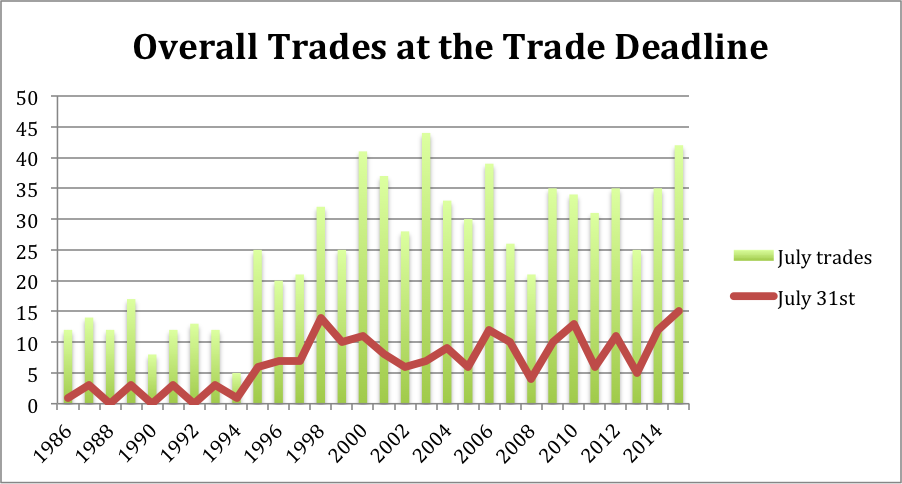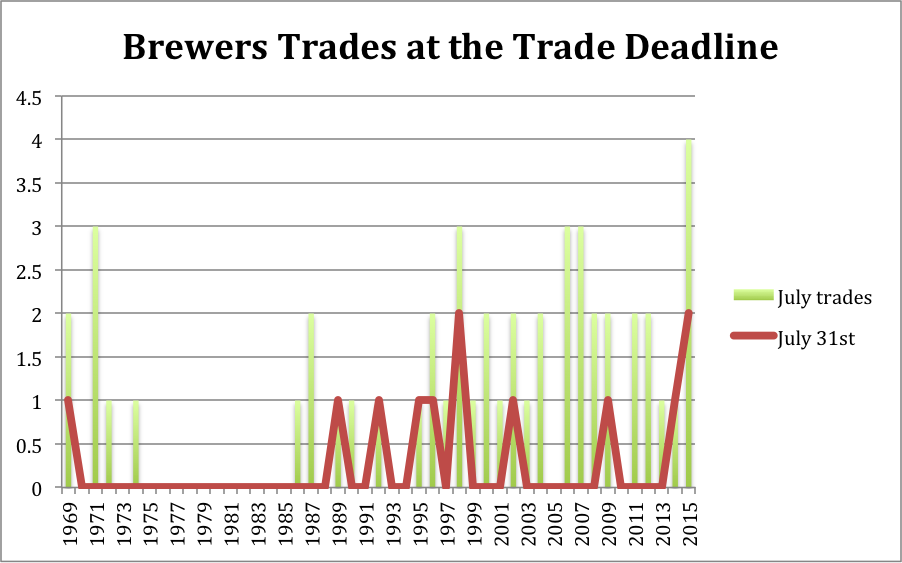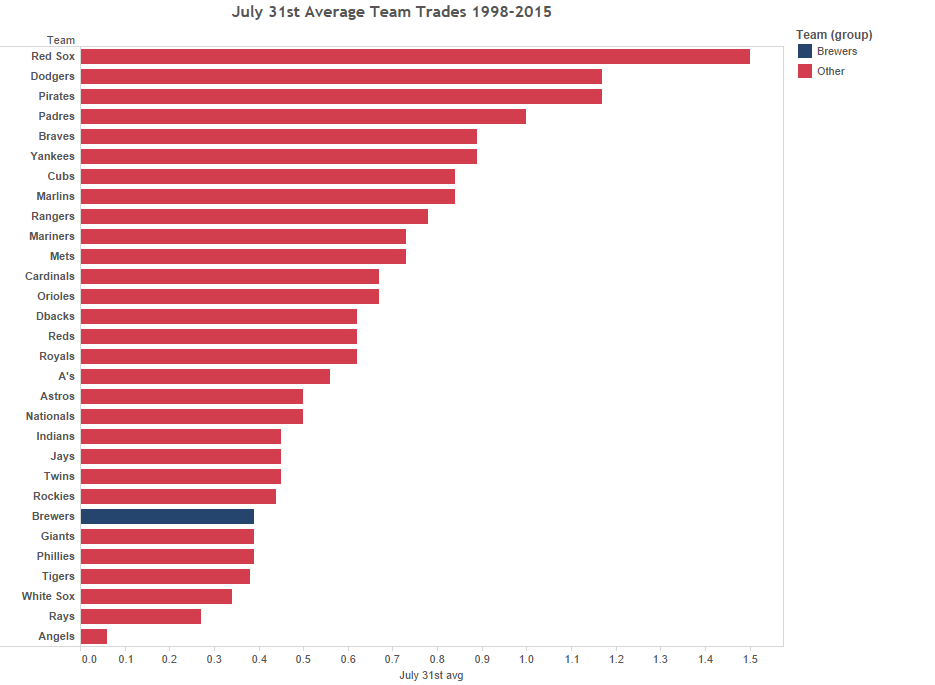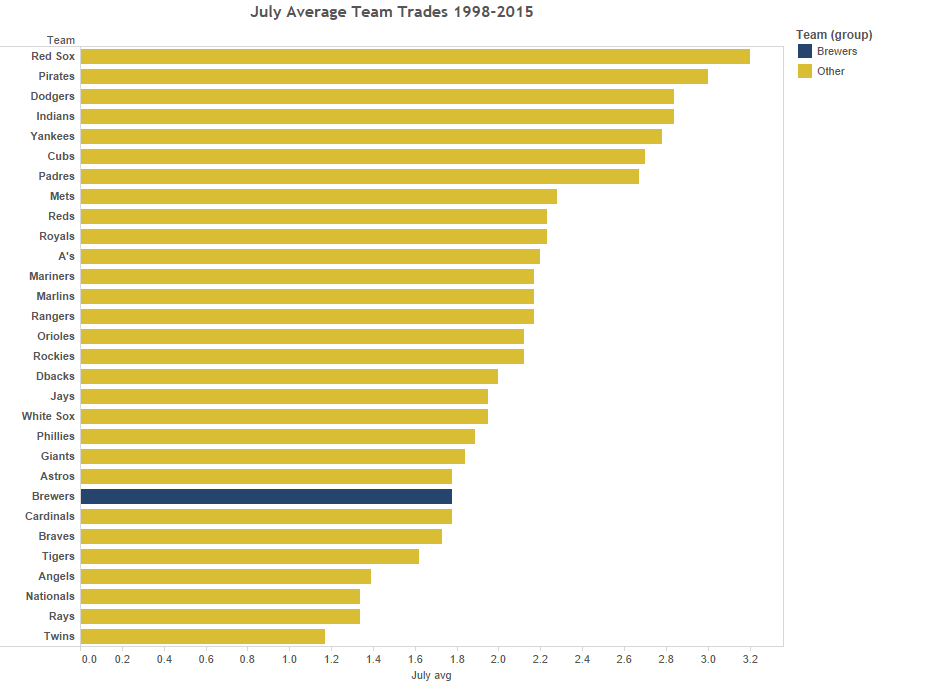Last year’s trade deadline seems to linger so closely, it could’ve been yesterday. The Rays, Tigers, and Mariners combined for a blockbuster three-team deal sending David Price to the Tigers; Nick Franklin, Drew Smyly, and Willy Adames to the Rays; and Austin Jackson to the Mariners. The Red Sox went nuts as well, almost revamping their entire team in seemingly hours, as they traded Jon Lester, John Lackey, Andrew Miller, and Stephen Drew to various teams. The Brewers, of course, traded for Gerardo Parra — although that felt more like a side note amidst all the madness.
This trade deadline seemed as though it would be even crazier than last year’s. In the middle of the swarming rumors was San Diego’s A.J. Preller, who after seeing his offseason moves flameout was reportedly ready to turn the tide and rebuild his entire team. The trade deadline came and went, yet Preller made no meaningful trades. At least, that’s if you don’t count the Padres’ acquisition of Marc Rzepczynski, the left-handed reliever brought in to strengthen their bullpen in case of an unlikely playoff push. Alas, this trade deadline will probably be remembered more for the moves that didn’t happen, as opposed to the moves that did transpire.
But, as I will attempt to prove below, a narrative such as this would be false and rather unfortunate, because this was one of the most active trade deadlines in history.
First, though, let’s acknowledge history. While most people know the non-waiver trade deadline happens July 31st, many don’t remember that its present format only dates back to 1986. Before that, the deadline took place on June 15, and it was that way for six decades. The first trade deadline “was established in the National League in 1917. After August 20 of each year, players had to clear waivers within the league before they could be sold or traded to another team (of either league). The AL established a similar rule in 1920, with a deadline of July 1. In 1921, both leagues agreed on a trade deadline of August 1. Following the 1922 season, the deadline was changed to June 15, where it remained for decades.”
Now, there are a number of ways to determine the given activity prior to any trade deadline. The way I chose to do it was to examine every trade that happened in July — as well as on July 31st itself. The reason for this is that the biggest moves rarely happen on the day of the deadline. They occur on the days leading up to it. Just look at the Carlos Gomez deal. A franchise-altering player was traded from Milwaukee to Houston. The data was gathered from Baseball-References’ MLB transactions history. I did not include waiver claims, players released, or players signed. I did include players that were purchased, and players that were traded for future considerations.
Let’s look at the results. For the Brewers, I decided to look back at their entire history as a franchise. For the league wide results, I went back to 1986, the deadline in its current format.
It might be a little hard to tell, given the amount of information in the graphs, but 15 trades occurred on July 31st this year. That is the highest number of trades to ever happen on that date — even more than last year when 12 trades were made. When it comes to July trades, 42 trades happened this July, which is the second-highest total since 1986. The most trades to ever occur in July after 1986 was in 2003, when 44 trades happened.
When it comes to the Brewers, they only made two trades on the actual deadline day, which may not initially seem like they’ve been very active. But that’s tied for the most trades the Brewers have ever pulled off on July 31st. As for the overall number of July trades, the graph pretty much speaks for itself. The four trades that happened this July were the most in the franchise’s history. So Dealin’ Doug, was in fact dealing.
Doug Melvin became the general manager of the Brewers in 2002. Since he’s been in charge, as you can see, the team’s activity has risen in July. Whether this type of activity would have happened regardless of Melvin’s leadership, I do not know. Although, I would hypothesize that it would have happened either way. The league as a whole started trading more after the 2004 lockout-shortened season. Plus, when you consider the new advancement in analytics, the new breed of GMs, the expansion, and many other factors, it’s no wonder that more trades are happening now than ever before.
Adding Further Context
While the Brewers have definitely been active this trade deadline (at least when you compare it to the club’s history), it doesn’t mean they’re generally an active team. I looked at, on average, how often each team makes a trade on July 31st and in July. For this, I analyzed data from 1998 until 2015, due to the introduction of the expansion teams. Since 1986, there have been four expansion teams, the Rockies, Marlins, Diamondbacks, and Devil Rays. Therefore, in order to get the same sample size for every team, I went back only to 1998. The methodology is the same as before.
Since 1998, the Brewers have averaged 0.39 trades on July 31st, which ranks them 23rd out of the 30 major-league teams. In the month of July they’ve averaged 1.78 trades, which again ranks them among the least-active teams in baseball (22nd) during that time frame.
Therefore, while this may not seem like an active trade deadline, Brewers fans definitely shouldn’t take it as a passive one. Could the Brewers have done more? Yes! They could have traded Adam Lind, or Jean Segura, or even Jonathan Lucroy. Perhaps, though, the market simply wasn’t there for those players. The Brewers also didn’t have to trade them. It’s possible that the club wasn’t satisfied with the offers presented and will still look to move those players in the winter.
The trade deadline often offers a lot more hype than actual excitement. It’s the nature of the beast. There are always a ton of rumors, but lately the trade deadline has provided a lot more action. More trades are happening with more rumors are happening than ever. As a fan of the game, it’s exciting. New GM’s are getting more creative with their trades. They’re getting smarter and more realistic about their team’s position in the game, and all seem to have a plan. It’s exciting to think of what’s ahead, as it’s an exhilarating time to be a baseball fan.




